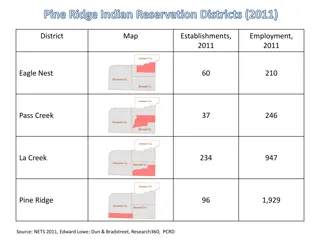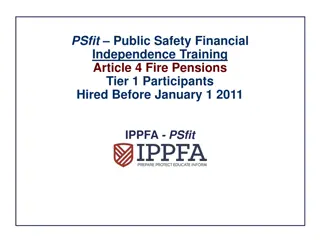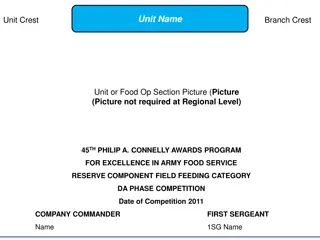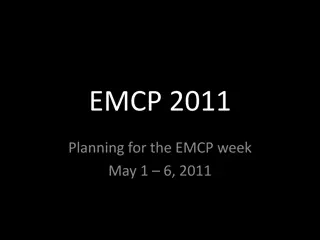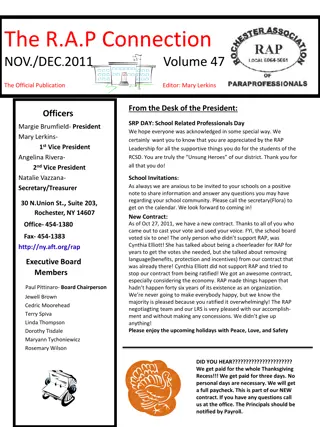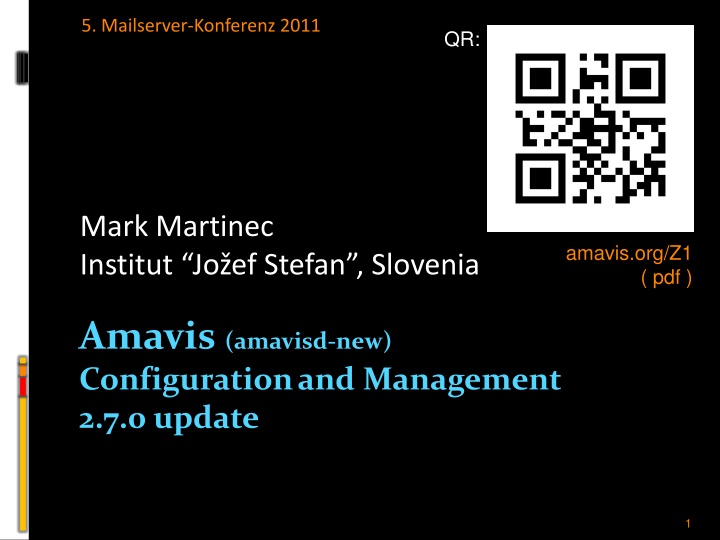
AMaViS: Configuration and Management Overview
Explore the key aspects of AMaViS, an interface between MTA and virus checkers, including its features, popularity factors, history, and recent updates. Learn about its reliability, standards compliance, and security measures, making it a preferred choice for email filtering and scanning.
Download Presentation

Please find below an Image/Link to download the presentation.
The content on the website is provided AS IS for your information and personal use only. It may not be sold, licensed, or shared on other websites without obtaining consent from the author. If you encounter any issues during the download, it is possible that the publisher has removed the file from their server.
You are allowed to download the files provided on this website for personal or commercial use, subject to the condition that they are used lawfully. All files are the property of their respective owners.
The content on the website is provided AS IS for your information and personal use only. It may not be sold, licensed, or shared on other websites without obtaining consent from the author.
E N D
Presentation Transcript
5. Mailserver-Konferenz 2011 QR: Mark Martinec Institut Jo ef Stefan , Slovenia amavis.org/Z1 ( pdf ) Amavis (amavisd-new) Configurationand Management 2.7.0 update 1
Agenda what it is, quick project history some tuning hints updates on a 2.7.0 release pre-queue (proxy) filtering configuration: policy banks, lookups, cc monitoring 2
Amavis - what is it? interface between MTA and virus checkers and/or spam checkers like spamd for SA, but speaks standard SMTP checks for banned content and header syntax quarantining/archiving DKIM: signs and verifies signatures monitoring: SNMP, SQL log, nanny 3
why is it popular? reliable: checks status of every operation, internal asserts in case of a failure mail stays with MTA, not lost adheres to standards (SMTP, MIME, DSN, ...) reasonably fast, feature-rich maintainable: logging for troubleshooting security: perl, taint checks, can run chroot-ed mature: 9+ years of steady development OSS: GPL 2 license (+ BSD licensed tools) 4
AMaViS A Mail Virus Scanner shell program: 1997 1998 .. 2000 AMaViS Perl program: 2000-01 2003-03 Mogens Kjaer, Juergen Quade Christian Bricart, Rainer Link, Chris Mason ( amavis.org ) Amavis-perl Amavis-0.3.12 Chris Mason Lars Hecking Perl daemon: 2001-01 .. 2003-03 amavisd Geoff Winkless, Lars Hecking Perl, re-design 2002-03 .. 2003-03 amavis-ng Hilko Bengen 5
Amavis releases and events ... 2002-03-29 amavisd-new, pre-forked, Net::Server 2004-07-01 2.0 policy banks, IPv6 address formats 2005-04-24 2.3.0 @decoders, per-recip banning rules 2006-04-02 2.4.0 DSN in SMTP, %*_by_ccat 2007-04-23 2.5.0 blocking cc, new SMTP client 2008-01-13 SpamAssassin Project Mgmt Committee 2008-04-23 2.6.0 DKIM, bounce killer, TLS 2009-06-25 2.6.4 SNMP monitoring 6
... Amavis releases and events 2010-04-25 2.7.0-pre4 2011-02-03 2.7.0-pre14 2011-03-07 moved ML from SF to amavis.org (hosted by Patrick Ben Koetter and Ralf Hildebrandt) 2011-04-07 2.6.5 2011-05-19 2.6.6 2011-05-18 2.7.0-rc1 9+ years of steady amavisd-new development 7
Did it grow too large? 29.000 lines of Perl code (with comments) modules, loaded only what is needed half of memory footprint is SpamAssassin memory is not a limitation to mail size grows linearly, hardware exponentially 8
Is it slow? written in Perl perform operations on large chunks of data avoid line-by-line processing avoid copying data critical code paths are well optimized sanity limits and suitable data struct & alg the slow part is SpamAssassin, if enabled 9
SMTP read speedup example by a factor of 3.9 (non-TLS) 32.3 MiB/s by a factor of 11 for TLS The bottleneck was line-by-line reading due to SMTP dot-destuffing. Code reworked to operate on entire buffers, dealing with dot-stuffing intricacies when crossing buffer boundaries. 10
Network latency in SA a problem? DNS black and white lists (RBL) DCC, Razor, Pyzor network services The bottleneck in SpamAssassin is CPU, idle wait times are compensated by running more processes, the only cost is memory. 11
Performance parallelism msgs/s vs. maxproc 95% best maxproc 12
Performance: SpamAssassin msgs/s vs. maxproc virus checks only spam + virus checks 13
Some tuning hints choose number of processes to match CPU capacity avoid slow command-line virus scanners Linux syslogd: disable sync on MTA/amavisd logs turn on $quarantine_subdir_levels = 1 examine timing reports at $log_level = 2 observe nanny, $nanny_details_level = 2 separate disks for MTA spool and amavisd tmp separate MTA and amavisd hosts split load through multiple MX records 14
SpamAssassin tuning ideas use SQL for r/w Bayes and AWL databases alternatively: r/o cdb, updated offline compiled rules: sa-compile limit mail size, truncate since 2.6.3 / SA 3.3.0 avoid slow regexp rules (HitFrequencies.pm) reduce time limits on rbl, razor, pyzor use local caching DNS server, mirrored RBL examine SA timing reports at log level 2 15
New in 2.7.0 at a glance improved as a pre-queue proxy content filter per-recipient SpamAssassin Bayes & user prefs external DKIM signer next hop failover new macros, more informative logging SMTP/LMTP receive speedup Sophos-SSSP, Avira SAVAPI, clamd streaming ... 16
pre-queue filtering Benefits: can reject original SMTP session (eliminates bounce backscatter to 3rd parties) preferred to quarantine & discard or tag & deliver Drawbacks: tighter timing constraints no. of content filters is more tightly coupled to a number of concurrent SMTP sessions must cope with peaks, instead of averages 17
pre-queue filter requirements real-time nature no. of filters = no. of sessions (almost) SMTP end-of-data timeout at a mercy of client minimize disruption caused by a filter restart 18
Stricter time limits reworked sub-task time limiting needs SpamAssassin 3.3.0 or later: master_deadline, results despite aborted tests $child_timeout = 45 (good starting point) the longest time most SMTP clients are willing to wait, less than smtpd_proxy_timeout (100 s) 19
Warm/flying reload amavisd reload signals a HUP to a daemon daemon clears FD_CLOEXEC on socket fd and stores socket info to BOUND_SOCKETS daemon restarts itself by exec(), passing open socket descriptors to next incarnation new instance attaches sockets to inherited fd 20
pre-queue filtering Postfix new option since Postfix 2.7.0 (20091101) : smtpd_proxy_options = speed_adjust Postfix SMTP server receives an entire message before connecting to a before-queue (proxy) content filter decouples slow SMTP clients from content filters 21
pre-queue filtering Postfix postscreen(8) is a new Postfix 2.8 feature, reducing the load on pre-queue content filters: smtp inet n - n - 1 postscreen smtpd pass - - n - 150 smtpd -o smtpd_proxy_filter=inet:[127.0.0.1]:10010 -o smtpd_proxy_options=speed_adjust 22
External DKIM signer amavisd calls Mail::DKIM to pre-process a message for signing sends a prepared DKIM mail digest to an external signing daemon, along with a signing domain name and a selector (d, s) receives a signed digest (p) and inserts a signature header field into a message private keys can be kept hidden from amavisd 23
Penpals old but often neglected feature to reduce false positives Our.Alice@here > Some.Bob@example Some.Bob@example > Our.Alice@here also: Message-ID < > In-Reply-To, References 24
Bounce killer another old but often neglected feature to reduce foreign backscatter If a message looks like a bounce and contains a header section of original mail, check if that came from our server. If decisively not, drop it. 25
Configuration agenda general mail flow direction logging, syslog interfacing: input, output, milter policy banks lookups content categories 26
Configuration general all config settings: amavisd.conf-default directories, hostname, ... user (uid) destination, source $max_servers $nanny_details_level = 2; # verbosity: 0, 1, 2 27
Configuration mail flow direction origin: @mynetworks, $originating destination: @local_domains_maps originating (property of a message) local-recipient (property of a recipient) 0 0 ... open relay 0 1 ... inbound 1 0 ... outbound 1 1 ... internal-to-internal 28
Configuration destination list all your domains in @local_domains_maps (local, virtual aliases, virtual mailbox, relay) affects: inserting header fields X-Spam-*, X-Quarantine-ID, X-Amavis-OS-Fingerprint, ... adding address extension (plus addressing) recipient notifications pen pals defanging statistics / SNMP 29
Configuration origin (source) origin: @mynetworks, $originating affects: DKIM signing inserting disclaimers bounce killer pen pals MYUSERS policy bank statistics / SNMP 30
Configuration origin (source) setting the $originating flag: implicitly: @mynetworks explicitly, typically through a policy bank: $inet_socket_port = [10024, 10026]; $interface_policy{'10026'} = 'ORIG'; $policy_bank{ ORIG'} = { originating => 1, }; 31
Configuration flow direction 2.7.0 new SQL fields: msgs . originating msgrcpt . is_local see message flow direction from SQL log 32
Mail direction in SpamAssassin internal_networks trusted_networks msa_networks 2.7.0: passes a value of the $originating flag to SpamAssassin 3.4.0, treated like msa_networks 33
Configuration logging SA amavisd error warn info dbg syslog LOG_CRIT LOG_ERR LOG_WARNING LOG_NOTICE LOG_INFO LOG_INFO LOG_DEBUG LOG_DEBUG LOG_DEBUG -3 -2 -1 0 1 2 3 4 5 34
Configuration syslog $do_syslog = 1; (pre-2.7.0: $DO_SYSLOG) $syslog_facility = 'user'; $log_level = 2; # verbosity 0..5 35
Configuration /etc/syslog.conf user.err; mail.crit; ... user.notice user.info user.debug /var/log/messages /var/log/amavisd.log /var/log/amavisd-info.log /var/log/amavisd-debug.log Prepend ' ' to a filename on Linux to disable sync! 36
Configuration log template $log_templ = <<'EOD'; [?%#D|#|Passed # [...] [? %q ||, quarantine: %q]# [? %Q ||, Queue-ID: %Q]# [? %m ||, Message-ID: %m]# [? %r ||, Resent-Message-ID: %r]# , mail_id: %i# , Hits: [:SCORE]# , size: %z# [...] EOD 37
Configuration log template $log_templ $log_recip_templ macros: README.customize From, Subject, Message-Id, User-Agent, size, Hits, Tests, banning, DKIM id, ... 38
Configuration log template two pre-defined log templates: $log_templ = $log_short_templ; # default $log_templ = $log_verbose_templ; 39
Configuration log template new macros: client_helo, client_port, actions_performed, mime2utf8, rusage, ... 40
Configuration log template new macro: actions_performed action: Accepted, Relayed, RelayedTagged, Discarded, Rejected, Bounced, NoBounce, TempFailed flow direction: Inbound, Internal, Outbound, OpenRelay 41
Configuration log template new macro: actions_performed examples: Passed CLEAN {RelayedOutbound}, ... Passed CLEAN {RelayedInbound}, ... Passed CLEAN {RelayedInternal,RelayedOutbound}, Passed SPAMMY {RelayedTaggedInbound}, ... Blocked SPAM {RejectedInbound,Quarantined}, ... Blocked INFECTED (Mal/BredoZp-B) {DiscardedInbound,Quarantined}, ... 42
Configuration logging 2.7.0: passing queue-id end-to-end (XFORWARD IDENT Postfix 2.8.0) back-end MTA: postfix/smtpd[72995]: 553261D1CB0: client=localhost[::1], orig_queue_id=2F5971D1CA3, orig_client=... post-queue content filter: amavis[20341]: (20341-15) Passed CLEAN ... Queue-ID: 2F5971D1CA3, queued_as: 553261D1CB0 front-end MTA: postfix/lmtp[73130]: 2F5971D1CA3: ... relay=127.0.0.1[127.0.0.1]:10024, status=sent (250 2.0.0 from MTA(smtp:[::1]:10025): 250 2.0.0 Ok: queued as 553261D1CB0) 43
Configuration input interface SMTP or LMTP or AM.PDP or AM.CL on input $inet_socket_port = [10024, 10026, 10027]; # TCP port numbers @inet_acl = qw( 127.0.0.0/8 [::1] 192.168.1.1 ); # access control $inet_socket_bind = '127.0.0.1'; # restrict to one interface $unix_socketname = '/var/amavis/amavisd.sock'; # quarantinerelease or milter 44
Configuration input interface 2.7.0: a list @listen_sockets represents a unified configuration of listening sockets. Combined: $unix_socketname, $inet_socket_bind, $inet_socket_port @listen_sockets = (10024, '*:10026', '127.0.0.1:9998', '[::1]:9998', '192.0.2.0:10028', "$helpers_home/amavisd.sock" ) 45
Configuration output SMTP or LMTP or pipe on output $forward_method = 'smtp:[127.0.0.1]:10025'; $notify_method = 'smtp:[127.0.0.1]:10025'; $forward_method = 'smtp:*:*'; $notify_method = 'smtp:*:10587'; 1st asterisk use SMTP client peer address 2nd asterisk incoming SMTP/LMTP session port no. plus one $virus_quarantine_method, $spam_quarantine_method, ... 46
Configuration output 2.7.0: Failover or simpleminded load balancing in SMTP and LMTP client a list of next-hop destinations Typical usage in $forward_method, $notify_method, $resend_method, $release_method, $requeue_method $forward_method = [ 'smtp:[::1]:10025', 'smtp:[127.0.0.1]:10025', 'smtp:*:10025' ]; $notify_method = [ 'smtp:*:*', 'smtp:192.0.2.10:10025' ]; 47
Configuration output by recipient: @forward_method_maps by contents category %forward_method_maps_by_ccat custom hook: $msginfo->delivery_method( ... ) 48
Configuration milter setup $unix_socketname = '/var/amavis/amavisd.sock'; $interface_policy{'SOCK'} = 'SOMEMILTER'; $policy_bank{'SOMEMILTER'} = { protocol => 'AM.PDP', }; $forward_method = undef; $notify_method = 'pipe: ... sendmail -Ac -i -odd -f ${sender} -- ${recipient}'; 49
Policy banks one global, currently in effect, set of configuration variables several replacement sets (groups) of configuration variables, prepared in advance and on stand-by, quickly loadable affects message as a whole (not per-recipient) 50

